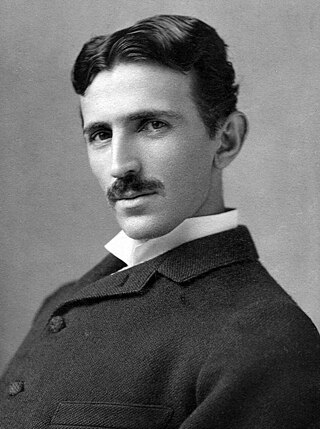
Nikola Tesla was a Serbian-American inventor, electrical engineer, mechanical engineer, and futurist. He is known for his contributions to the design of the modern alternating current (AC) electricity supply system.
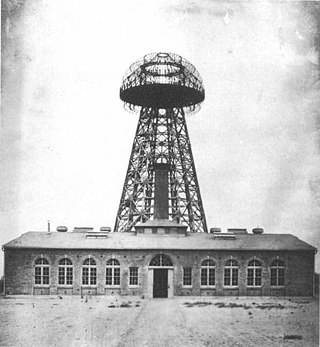
Wardenclyffe Tower (1901–1917), also known as the Tesla Tower, was an early experimental wireless transmission station designed and built by Nikola Tesla on Long Island in 1901–1902, located in the village of Shoreham, New York. Tesla intended to transmit messages, telephony, and even facsimile images across the Atlantic Ocean to England and to ships at sea based on his theories of using the Earth to conduct the signals. His decision to increase the scale of the facility and implement his ideas of wireless power transmission to better compete with Guglielmo Marconi's radio-based telegraph system was met with refusal to fund the changes by the project's primary backer, financier J. P. Morgan. Additional investment could not be found, and the project was abandoned in 1906, never to become operational.

Harry Grindell Matthews was an English inventor who claimed to have invented a death ray in the 1920s.
The Nikola Tesla electric car anecdote refers to a supposed invention described by Peter Savo, who claimed to be a nephew of Nikola Tesla.

Nikola Tesla is portrayed in many forms of popular culture. The Serbian-American engineer has particularly been depicted in science fiction, a genre which is well suited to address his inventions; while often exaggerated, the fictionalized variants build mostly upon his own alleged claims or ideas. A popular, growing fixation among science fiction, comic book, and speculative history storytellers is to portray Tesla as a member of a secret society, along with other luminaries of science. The impacts of the technologies invented by Nikola Tesla are a recurring theme in the steampunk genre of alternate technology science-fiction.
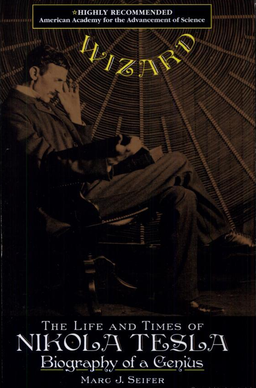
The book Wizard, the Life and Times of Nikola Tesla is a biography of Nikola Tesla by Marc J. Seifer published in 1996.

The Inventions, Researches and Writings of Nikola Tesla is a book compiled and edited by Thomas Commerford Martin detailing the work of Nikola Tesla through 1893. The book is a comprehensive compilation of Tesla's early work with many illustrations.
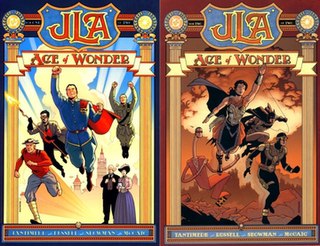
JLA: Age of Wonder is a 2003 two-issue mini-series of comics from DC's Elseworlds imprint. Taking place from 1876 to 1913, the comics follow Clark Kent and Lex Luthor as they use superpowers to create technical innovations. The comics also follow the creation of the League of Science, a superhero league dedicated to spreading these innovations for the good of mankind. The series was written by Adisakdi Tantimedh, with art by P. Craig Russell and Galen Showman.

Tesla's electro-mechanical oscillator is a steam-powered electric generator patented by Nikola Tesla in 1893. Later in life Tesla claimed one version of the oscillator caused an earthquake in New York City in 1898, gaining it the popular culture title "Tesla's earthquake machine".
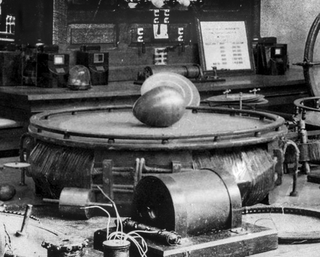
Tesla's Egg of Columbus was a device exhibited in the Westinghouse Electric display at the 1893 Chicago World's Columbian Exposition to explain the rotating magnetic field that drove the new alternating current induction motors designed by inventor Nikola Tesla by using that magnetic field to spin a copper egg on end.
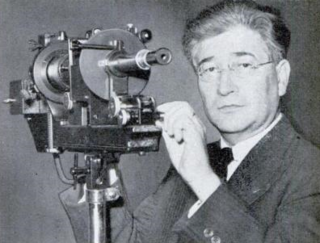
Antonio Longoria was a scientist who claimed to have invented a death ray in the 1930s.
Teleforce is a proposed defensive weapon by Nikola Tesla that accelerated pellets or slugs of material to a high velocity inside a vacuum chamber via electrostatic repulsion and then fired them out of aimed nozzles at intended targets. Tesla claimed to have conceived of it after studying the Van de Graaff generator. Tesla described the weapon as being able to be used against ground-based infantry or for anti-aircraft purposes.

A raygun is a science-fiction directed-energy weapon that releases energy, usually with destructive effect. They have various alternate names: ray gun, death ray, beam gun, blaster, laser gun, laser pistol, phaser, zap gun, etc. In most stories, when activated, a raygun emits a ray, typically visible, usually lethal if it hits a human target, often destructive if it hits mechanical objects, with properties and other effects unspecified or varying.

The World Wireless System was a turn of the 20th century proposed telecommunications and electrical power delivery system designed by inventor Nikola Tesla based on his theories of using Earth and its atmosphere as electrical conductors. He claimed this system would allow for "the transmission of electric energy without wires" on a global scale as well as point-to-point wireless telecommunications and broadcasting. He made public statements citing two related methods to accomplish this from the mid-1890s on. By the end of 1900 he had convinced banker J. P. Morgan to finance construction of a wireless station based on his ideas intended to transmit messages across the Atlantic to England and to ships at sea. His decision to change the design to include wireless power transmission to better compete with Guglielmo Marconi's new radio based telegraph system was met with Morgan's refusal to fund the changes. The project was abandoned in 1906, never to become operational.

Goliath is a biopunk/steampunk novel by Scott Westerfeld, and illustrated by Keith Thompson. The novel is the third and final installment in the Leviathan series after Behemoth, released on September 20, 2011.

John George Trump was an American electrical engineer, inventor and physicist. A professor at the Massachusetts Institute of Technology (MIT) from 1936 to 1973, he was a recipient of the National Medal of Science and a member of the National Academy of Engineering. Trump was noted for developing rotational radiation therapy. Together with Robert J. Van de Graaff, he developed one of the first million-volt X-ray generators. He is the uncle of Donald Trump.
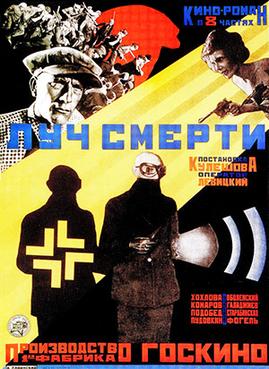
The Death Ray is a 1925 Soviet science fiction film directed by Lev Kuleshov. The first and last reels of the film have been lost. This film ran at 2 hours, 5 minutes, making this one of the earliest full length science fiction films. Despite the fact that many sources claim the inspiration for the film to be the novel The Garin Death Ray by Aleksei Tolstoy, this is not the case. It is impossible, since the book was published two years after the film, in 1927. Furthermore, the film has many similarities with a book by Valentin Kataev, called Lord of Iron, published in 1924. Moreover, the theme of death rays was very popular at the time because of the 1923 claim of British inventor Harry Grindell Matthews to have created a "death ray".

Nikola Tesla patented the Tesla coil circuit on April 25, 1891. and first publicly demonstrated it May 20, 1891 in his lecture "Experiments with Alternate Currents of Very High Frequency and Their Application to Methods of Artificial Illumination" before the American Institute of Electrical Engineers at Columbia College, New York. Although Tesla patented many similar circuits during this period, this was the first that contained all the elements of the Tesla coil: high voltage primary transformer, capacitor, spark gap, and air core "oscillation transformer".

Tesla is a 2020 American biographical drama film written and directed by Michael Almereyda. It stars Ethan Hawke as Nikola Tesla. Eve Hewson, Ebon Moss-Bachrach, Jim Gaffigan, and Kyle MacLachlan also star.















